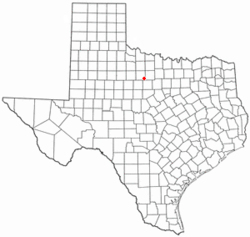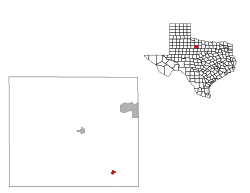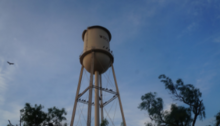Woodson, Texas
Woodson, Texas | |
|---|---|
 Location of Woodson, Texas | |
 | |
| Country | United States |
| State | Texas |
| County | Throckmorton |
| Area | |
• Total | 0.6 sq mi (1.7 km2) |
| • Land | 0.6 sq mi (1.7 km2) |
| • Water | 0.0 [1] sq mi (0.0 km2) |
| Elevation | 1,227 ft (374 m) |
| Population (2010) | |
• Total | 264 |
| • Density | 440/sq mi (160/km2) |
| Time zone | UTC-6 (Central (CST)) |
| • Summer (DST) | UTC-5 (CDT) |
| ZIP code | 76491 |
| Area code | 940 |
| FIPS code | 48-80188[2] |
| GNIS feature ID | 1350567[3] |
Woodson is a town in Throckmorton County, Texas, United States. As of 2014, the population was estimated to be 258.[4]
Geography
Woodson is located at 33°0′56″N 99°3′8″W / 33.01556°N 99.05222°W (33.015517, -99.052276)[5] in North Central Texas. It is situated at the junction of U.S. Highway 183 and Farm Roads 209 and 1710 in southeastern Throckmorton County, approximately 15 miles (24 km) southeast of Throckmorton.[6]
According to the United States Census Bureau, the town has a total area of 0.6 square miles (1.7 km²), all of it land.
Climate
The climate in this area is characterized by hot, humid summers and generally mild to cool winters. According to the Köppen Climate Classification system, Woodson has a humid subtropical climate, abbreviated "Cfa" on climate maps.[7]
Wildlife
Woodson is situated in semi-arid rolling hills covered in mesquite with "jumping" and prickly pear cactus, "blue brush" and occasional live or post oaks. It has often hot dry summers and cold dry winters. The creek bottoms have huge pecan trees, hackberry, willow, "china berry", "chitelm", elm, cottonwood, and wild plums of several kinds as well as many other trees of various types occurring at times (bois d'arc, and mulberry are seen). The ground along creeks may be covered in green briars, poison ivy or oak and Virginia creeper grows high into the trees in places. The land, as a whole, is a patchwork of mesquite, and farm fields dotted with old oil wells. It is home to white-tailed deer, wild turkey, cotton-tailed and jack rabbits, feral hogs, bobcats, raccoons, opossum, rattlesnake, bobwhite quail, mourning doves, armadillo, coyotes, an occasional badger, beaver, fox, mountain lion, and even javalina is seen. Song birds and others thrive. There are many small animals like fox squirrels, hispid cotton rats, soft-shelled turtles and others too numerous to mention. Large yellow catfish live in the slow moving rivers or in the local lake and stock tanks (ponds) along with many other fish like channel catfish, large-mouthed bass (black bass), crappie, gar, carp, buffalo fish, drum, bream and goggle-eyed sun perch. Red-horse minnows, top-water minnows and a species locally known as bull-head minnows live in the ponds and thrive in the rippling shallows of the river and creeks.
History
The area was initially settled in 1875 by J.O. Wood and Henry McClintick. Wood's son, O.J. Wood, played a leading role in the shaping of the community and its economics. Woodson was originally called Jom, when it was established around a cotton gin built so that the ranchers could get cotton seed to feed to cattle. After Jom was established, O.J. Wood deeded lots measuring 100 feet (30 m) by 190 feet (58 m) to anyone who would build a residence there, free of charge. This caused businesses to start popping up, as a post office and Wood and Sons grocery were established.

Since J.O. Wood and his son built the first schoolhouse in town, it was decided that the town should be called Wood and Son, to honor the two. Throughout time, it was changed to Woodson, which has become the official name. Woodson eventually became a booming town, with an official start date in 1903. The first highway to Breckenridge was built in 1920.
Wood and his son also reportedly built the First Christian Church, located in the center of town on Highway 183, in the 1900s. When the original schoolhouse grew too small to hold all of Woodson’s students, the First Christian Church was used as an additional educational space.
Another result of the increase in people was the building of a railroad that came through Woodson. According to Big Country: People, Events and Places, Volume V, the line was owned and operated by the Texas and Pacific Railroad.[8] The land for the right of way was obtained in three ways; some was bought outright from the owners. If the owners refused to sell, the Texas and Pacific took it by easement. Some landowners gave the land for the right of way; for instance, the Dickie family gave land through the East Woods to the company. Local men helped build the roadbed and lay the tracks. Once the train was built, it made one run from Cisco to Throckmorton each day.
Thanks to the railroad and the oil field boom, Woodson grew for a long period of time. There were three service stations where residents could fill up with gas, two cotton gins, two barber shops and a lumber yard. Where Jones Trailer sits today is where one of the barber shops used to be, and the other was stationed where the post office is now. The County Line (located on Highway 183, toward Breckenridge) used to be Woodson’s post office, and today’s Woodson Grocery was actually the first bank in town.

At one point, Woodson also had a movie theater (next to the Woodson Inn), Chevrolet house, drugstore and feed store, next to which a local physician, Doctor Turner, ran a practice.
Woodson originally received its water from the city lake (south of town, on the right side of Highway 183, which is now known as Dickie Lake).
1948 Tornado
“For a week, there had been misting rain and thunderstorms, but not one was prepared for the tornado that hit that night, about 10:30, while almost everyone was asleep. The Woodson storm path was a mile and a half long and 200 yards wide. In the area, trees were uprooted, telephone poles flattened, houses razed, roofs damaged and windows broken. The most seriously injured by the storm was a 45-year-old man named Willie Peacock. He suffered a broken hip when parts of his house fell on him. His wife suffered a severe shoulder sprain…and their daughter Juanell, 13, was cut by flying glass.”
When a tornado hit Woodson in 1948, the population had decreased to 500. Still, 32 houses were destroyed, as reported in Big Country: People, Events and Places, Volume V. This is the only tornado that has ever hit the town - though a bad hail storm caused damage in 2003.
Japanese Balloon Bomb
In the same year, a rancher on the Barney Davis Ranch, eight miles north of Woodson, Ivan Miller, found a balloon bomb in his field. The war in Europe was coming to an end, so attention was turned to finishing the job against the Japanese in the Pacific. However, the balloons obviously failed, as one ended up in a local field and the other, in Eastland County’s Desdemona.
Miller’s widow recalled later that he described the balloon to be “as big around as a house,” with a large rising sun painted on its top and several smaller versions around the bottom.
About 360 bombs were eventually found in North America, though government officials requested that all pieces be returned.[9]
Surrounding Communities
When Woodson was at its peak population, it had “suburbs” of sorts - surrounding communities with their own families, businesses and school, which all eventually consolidated into Woodson ISD in the late 1930’s.

- Titus: located west of town at the corner of Highway 209 and FM 2850
- Lusk: located south of town, close to where the Dyer family lives
- Masters: located north of town off of FM 1710, out past a curved road
- Sunshine: located by where the Mathiews family lives
- Hustuttle: located off of the Crystal Falls highway, past the turn to Eliasville
- Whiz Bang: Around 1930, a small boom town appeared near Woodson, on the road from Woodson to Masters (now 1710) There was a refinery, post office, couple of cafes and grocery stores, two-story hotel, great deal of makeshift dwellings and strip-tease act on weekends. E.T. Parrott and Bill Elliott owned the land that made up Whiz Bang, which sprang up overnight and disappeared just as quickly. Now, only a few crumbled cement blocks of the refinery remain.
Demographics
| Census | Pop. | Note | %± |
|---|---|---|---|
| 1960 | 337 | — | |
| 1970 | 340 | 0.9% | |
| 1980 | 291 | −14.4% | |
| 1990 | 262 | −10.0% | |
| 2000 | 296 | 13.0% | |
| 2010 | 264 | −10.8% | |
| 2015 (est.) | 254 | [10] | −3.8% |
From 1920 to 1930, Woodson’s population was at an all-time high, with a count of 2,800 people. Due to surrounding areas growing, Woodson has since decreased in size. In 1948, the population was down to about 500 people.
There were 113 households out of which 33.6% had children under the age of 18 living with them, 54.9% were married couples living together, 13.3% had a female householder with no husband present, and 29.2% were non-families. 27.4% of all households were made up of individuals and 15.0% had someone living alone who was 65 years of age or older. The average household size was 2.62 and the average family size was 3.23.

In the town the population was spread out with 29.1% under the age of 18, 7.1% from 18 to 24, 24.0% from 25 to 44, 21.6% from 45 to 64, and 18.2% who were 65 years of age or older. The median age was 39 years. For every 100 females there were 89.7 males. For every 100 females age 18 and over, there were 87.5 males.
The median income for a household in the town was $26,389, and the median income for a family was $30,625. Males had a median income of $26,111 versus $14,750 for females. The per capita income for the town was $13,401. About 17.7% of families and 12.5% of the population were below the poverty line, including 13.1% of those under the age of eighteen and 13.5% of those sixty five or over.
As of the census of 2010, there were 264 people, a decrease of 10.81% since 2000 (32 people). The racial makeup of the town was 92.80% White (245 people), 2.65% African American (7 people), 3.41% from other races (9 people), and 1.14% from two or more races (3 people). Hispanic or Latino of any race were 15.91% of the population (42 people). In 2014, the population was estimated to be 258.
Education
Public education is provided by the Woodson Independent School District. WISD is home of the Woodson Cowboys and Cowgirls, and the school colors are black and gold. The school motto - “Be The Best You Can Be” - was chosen when Danny Bellah was working on his principal certificate; Bellah - who graduated from Woodson High in 1969, started working at the school in 1980 [as the girls’ basketball coach and high school math teacher] and eventually moved up to be the principal and superintendent - and other administrators in the area were encouraged to come up with a slogan for their schools. While on a mission to find the perfect quote for the school, he was encouraged to “be his best” in various ways, such as hearing the University of Arkansas’ head football coach say it and then seeing it on a magnet he received at church. He took those as signs, and the motto stuck.

Pre-kindergarten through 12th grade can attend WISD, and as of 2016, there were 149 students in school, with 29 faculty and staff members. Despite the small numbers, Woodson offers many extracurricular activities, such as:
- Junior and high school basketball
- Junior and high school volleyball
- Junior and high school football
- Junior and high school track and cross country
- Junior and high school cheerleading
- Tennis
- Golf
- FFA
- National Honor Society
- One Act Play
- UIL academic events
- School newspaper
- Robotics
Notable achievements for the Cowboys and Cowgirls include the following events:
- Volleyball: Area champions in 2000, 2002, 2003, 2004, 2005 & 2007. Bi-district champions in 1959, 1980, 1998, 1999 & 2006. The Cowgirls made it to the playoffs in 2016, for the first time in 10 years.
- Girls’ Basketball: Bi-district champions in 2000, 2001 & 2003. District champions in 1951, 1956 & 1980. The girls’ teams saw success under Coach Danny Bellah from 1980-1986, and under Coach Melissa Vickers from 1993-2006.
- Track: Cindy Harper Parker went to state in track and cross country four years and won twice, in the 1600 and 3200. In her high school career, she won six gold medals. Ryder Peacock went to state in the high jump in 2002, setting the 1-A state record at 7-0 1/4. Madison Frazier was a 200-meter state qualifier and won state in the 400-meter race. In 2016, she beat her own time, with a 59.89.
- Boys’ Basketball: Regional finalists in 2002. Bi-district champions in 2006 & 2012. District champions in. 2000 & 2001.
- Football: State runners-up in 2008. State semi-finalists in 1980 & 2001. Quarterfinal champions & state runners-up in 1978 & 2007. Regional champions in 2006 & 2009. Bi- district champions in 1993, 1994, 1995 & 2000. District champions in 1957, 1960, 1967, 1973 & 1996. The boys’ teams saw success under Coach Gordon Thomas from 1992-2002, and under Coach Reece Walker from 2002-2008.
Sources of Income
Farming and ranching were the main sources of income until 1923, when the first oil well was completed. In 1925, the Stubblefield #1 well drilled by the Texas Oil Company (Texaco) came in flowing vast amounts of oil. It has since produced more than 1,000,000 barrels (160,000 m3) from that one well and in 2010 was still producing. This set off a local drilling boom, and Texaco even built a refinery north of Woodson, in Whiz Bang. Besides working the land and in the oil field, residents of Woodson can find employment through Woodson ISD, BJB Transport and the Jones Trailer Company.
References
- ^ "Population and Housing Unit Counts, 2010 Census of Population and Housing" (PDF). Texas: 2010.
- ^ "American FactFinder". United States Census Bureau. Retrieved 2008-01-31.
- ^ "US Board on Geographic Names". United States Geological Survey. 2007-10-25. Retrieved 2008-01-31.
- ^ Division, US Census Bureau, Data Integration. "Population Estimates". www.census.gov. Retrieved 2016-12-18.
{{cite web}}: CS1 maint: multiple names: authors list (link) - ^ "US Gazetteer files: 2010, 2000, and 1990". United States Census Bureau. 2011-02-12. Retrieved 2011-04-23.
- ^ "Woodson, Texas". Texas Escapes Online Magazine. Retrieved 2009-07-21.
- ^ Climate Summary for Woodson, Texas
- ^ "History of Woodson". Throckmorton County Chamber of Commerce. Retrieved 2009-07-21.
- ^ Kingston, Mike. "The Bombing of Texas". Texas State Historical Association Texas Almanac. Retrieved 2016-12-16.
- ^ "Annual Estimates of the Resident Population for Incorporated Places: April 1, 2010 to July 1, 2015". Retrieved July 2, 2016.
- ^ "Census of Population and Housing". Census.gov. Retrieved June 4, 2015.

